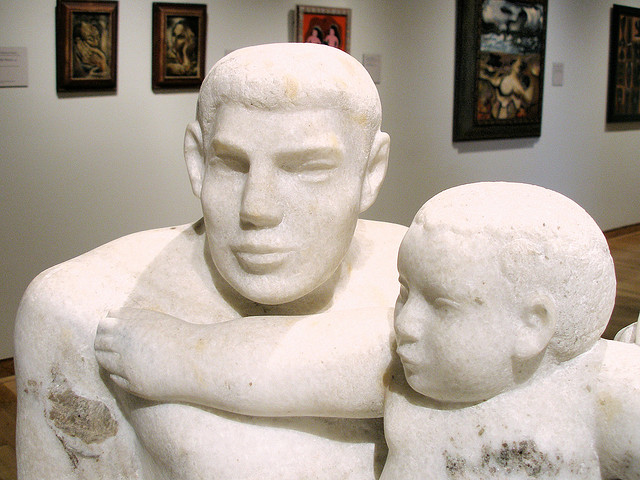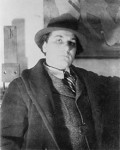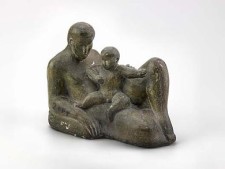

William Zorach
Lithuanian, 1887-1996 (active USA)
The Faith of This Nation is Eternal, 1939-1942
Georgian white marble
SBMA, Bequest of Wright S. Ludington

William Zorach circa 1917, photographed by Man Ray
"I would say to every young artist of great talent: live art, sleep art, think art, talk art, write art, in other words, marry art. Treasure talent in yourself and allow nothing to degrade it. Recognize your own talent; do not confuse it with the talent of another; allow every man his own without envy. Do not defeat yourself."
This is the credo of a man who rose from the depths of poverty to become one of America's leading sculptors. ART IS MY LIFE
by WILLIAM ZORACH
The Uninhibited Autobiography of a Famous Artist
RESEARCH PAPER
The Sculptor
William Zorach was born in Eurburg, Lithuania in 1887. He was brought to the United States at the age of four to rejoin his father who had emigrted to Port Clinton, Ohio. Zorach dropped out of school in Cleveland, working as a commercial lithographer (1902-1908). In 1908 William Zorach moved to New York to study at the National Academy of Design. He travels to Paris in 1910 to enroll at La Palette, a small modernist art school. While at La Palette Zorach meets his future wife, the artist Marguerite Thompson. Meeting Marguerite had a profound effect on the Metropolitan Museum of Art in New York and the Whitney Museum of American Art in New York. He also exhibited in San Francisco, Dallas and Chicago. By the time of his death in 1966, he had produced a formidable body of work. Forty years after his death his works are a part of the permanent collections of such museums as the Metropolitan Museum of Art in New York and the Santa Barbara Museum of Art.
His Art
The Faith of This Nation is Eternal
From lithography to painting, William Zorach went on to become the mature sculptor that produced this work. He became a “direct sculptor”, that is Zorach didn’t work with a clay model, but carved directly into the stone. “A piece of sculpture is made up of silhouettes,” Zorach wrote at about this time, “which move up in a spiral, which must function at every angle of the sphere. I like to be able to roll a stone piece around on the ground so that I can look at it from every position. You cannot do this with a model of clay.”
The Faith of This Nation is Eternal was created during World War II. The work pays homage to the strongest bond war tries to destroy, the bond between the men who fight and the children they try to protect. The piece is cut from Georgian marble. It is a very handsome piece. The reclining figure of a man, arm placed lengthwise about the figure of a young male child, who spreads himself trustingly upon the protecting form. The piece displays great human warmth and regard for nature, yet with a coordination of parts, distance, values and spaces.
In every way this marble carving adheres to the oldest rules for good sculpture: it is of a piece; flows with the growth of the marble; has no unanchored members; no stylization foreign to the material. It is intricate in its interplay of forms; delicate in the suggested sensuous touch of the two bodies.
Zorach’s work is not sentimental, but ennobling. He thought a long time before giving the sculpture a title. It comes from the closing words of an address made by President Franklin Roosevelt during World War II: The Spirit of This Nation is Strong; The Faith of This Nation is Eternal.
Conclusions
Years later William Zorach remembered the sculpture vividly, “For two summers I chipped away at a large stone of a father and son, the father reclining with his son, called ‘The Faith of This Nation.’ The stone is a white Georgia marble with considerable black and gray in it. It was an interesting stone, but very hard to carve; but sometimes difficulties are a challenge and bring out more power in the artist. It was shown at the Downtown Gallery.”
One day after the sculpture was shown at the gallery a private in the United States Army walked in and expressed an interest, saying he would return the following day. No one at the gallery believed he would return, but the next day he did; purchased the sculpture and had it sent to his home in Santa Barbara. He was Pvt. Wright S. Ludington.
In December 2000, the Santa Barbara Museum of Art received a request from the Portland Museum of Art; Portland, Maine, requesting the loan of The Faith of This Nation is Eternal to be displayed in a show of comprehensive works of Marguerite and William Zorach. There is strong evidence that his sculpture is based on a 1918 drawing by Marguerite of her husband and son. The drawing is in the permanent collection of the Smithsonian American Art Museum. The Portland Museum of Art hoped to juxtapose the two works in the show. They felt The Faith of This Nation is Eternal is one of the finest examples of William Zorach’s sculpture and exemplifies a theme that was central to both artists work; that strong, nurturing family relationships were critical to the future.
Prepared for the Santa Barbara Museum of Art Docent Council by Virginia G. Randolph, February 2004
Bibliography for Research Paper on William Zorach
Zorach, William. Art is My Life: The Autobiography of William Zorach. The World Publishing Company, Cleveland and New York, 1967. p.165.
Ibid.
Bauer, John S. H. William Zorach. Published for the Whitney Museum of American Art. Fredrick A. Praeger, Publishers, New York, 1959.
Hoffman, Marilyn Friedman. Marguerite and William Zorach: The Cubist Years: 1915- 1918. The Currier Gallery of Art, Manchester, New Hampshire, Catalogue, 1987.
Skwire, Jessica, ed. Marguerite & William Zorach:Harmonies and Contrasts. Portland Museum of Art, Maine, Catalogue, November 8, 2002 – January 6, 2003.
Turner, Jane, ed. The Dictionary of Art – Vol. 33. Grove Dictionaries Incorporated, New York, 1996.
Wingert, Paul S. The Sculpture of William Zorach. Pitman Publishing Corporation, New York, 1938.
Zorach, William. Art is My Life: The Autobiography of William Zorach. The World Publishing Company, Cleveland and New York, 1967.
Zorach, William. William Zorach. Published by the American Artists Group, Inc., New York, 1941.
, The Art Digest. March 1, 1943.
“Biography for the Artist Zorach, William.” AskART. 2004. 28 Jan 2004.
“William Zorach.” Encyclopaedia Britannica. 2004. Encyclopaedia Britannica Services. 18 Jan. 2004.

Faith of the Nation (study for) 1936, cast and patinated plaster, 7 x 8 x 4 3/4in., Smithsonian American Art Museum, Gift of Tessim Zorach and Dahlov Ipcar, 1971.449.9
